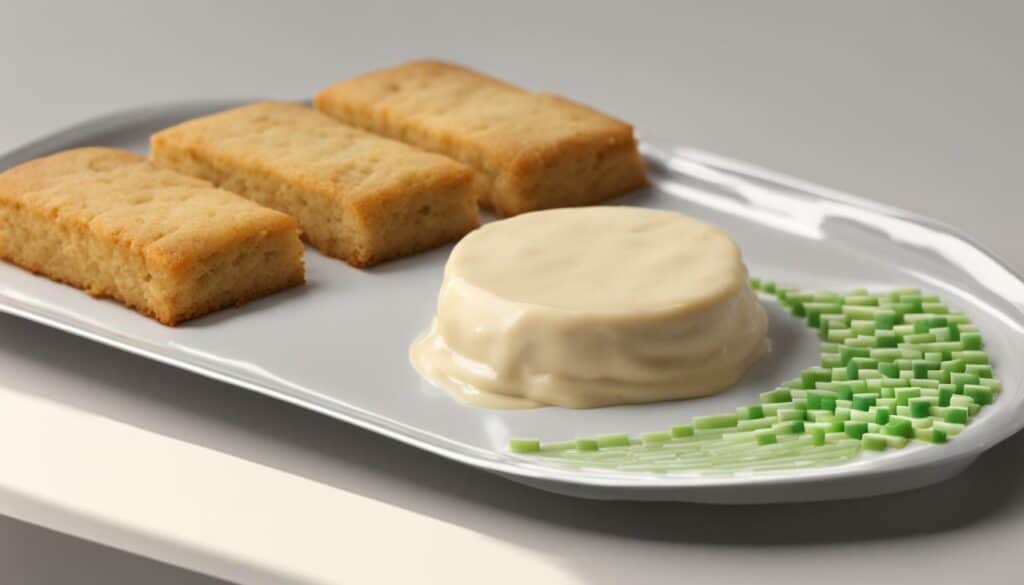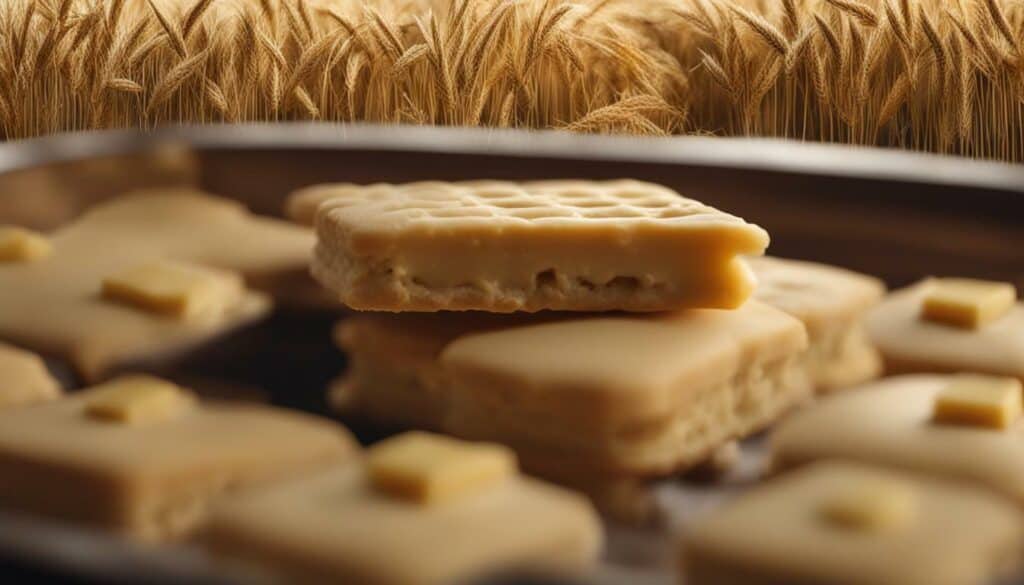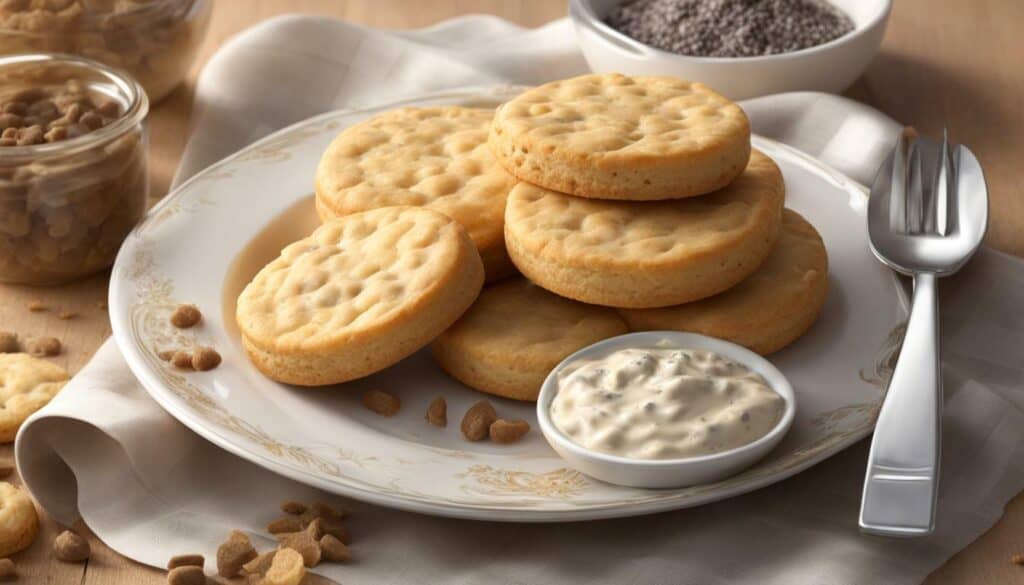Biscuit and gravy nutrition is a topic that deserves our attention, so let’s dig in and uncover the facts behind this beloved American dish. Biscuits with gravy are a popular meal, but understanding their nutritional value is essential for making informed dietary choices.
- Biscuits with gravy typically contain flour, fat, leavening agent, and milk or water.
- One biscuit (45 grams) contains 166 calories, 8.5 grams of fat, 19.3 grams of carbohydrates, 1.1 grams of fiber, 1.8 grams of sugar, and 3.2 grams of protein.
- Biscuits are high in sodium, with one biscuit providing nearly 20% of the daily recommended amount.
- They are a calorie-dense food, making them suitable for those struggling to maintain or gain weight.
- Biscuits may contain common allergens, such as wheat, dairy, or eggs, so it’s important to be mindful of any food allergies.
- The shelf-life of biscuits varies depending on the type, with fresh-baked biscuits lasting up to 18 days and refrigerated biscuit dough best before the use-by date.
While biscuits with gravy can be a tasty dish, it’s crucial to consider portion sizes and the overall nutritional value when incorporating them into your diet. By staying informed about biscuit and gravy nutrition, you can make healthier choices while still enjoying this classic comfort food.
Understanding Biscuit Ingredients and Nutrition
To understand the nutrition of biscuit and gravy, we need to start with the basic ingredients that make up the biscuit itself. Biscuits typically consist of flour, fat, a leavening agent, and milk or water. These simple ingredients come together to create the delicious and flaky texture that biscuits are known for.
Let’s take a closer look at each of these ingredients:
- Flour: The main component of biscuits, flour provides the structure and bulk. It is a source of carbohydrates, which are essential for energy.
- Fat: Fat adds flavor and moisture to the biscuits. It also contributes to the texture, making them soft and tender. Common fats used in biscuits include butter, shortening, or lard.
- Leavening agent: Biscuits typically use baking powder or baking soda as leavening agents. These ingredients react with the other components to create a light and fluffy texture.
- Milk or water: Liquid is needed to hydrate the dough and bind the ingredients together. Milk adds richness and flavor to the biscuits, while water is a more neutral option.
Now that we understand the ingredients, let’s delve into the nutritional aspects of biscuits. While biscuits can be a tasty treat, they are not the most nutrient-dense food. However, the exact nutritional values may vary depending on factors such as the recipe, brand, and serving size.

The table above provides a general overview of the nutritional information for a standard biscuit (45 grams). It contains 166 calories, 8.5 grams of fat, 19.3 grams of carbohydrates, 1.1 grams of fiber, 1.8 grams of sugar, and 3.2 grams of protein. It’s worth noting that these values may change depending on the specific biscuit recipe or brand.
Stay tuned for the next section, where we’ll explore the calorie and fat content in biscuits and how it can impact our overall health.
Calorie and Fat Content in Biscuits
Biscuits may be delicious, but they can also be quite calorie-dense. Let’s take a closer look at their calorie and fat content.
A standard biscuit (45 grams) contains 166 calories, making it a relatively high-calorie food. If you’re watching your calorie intake, it’s important to be mindful of portion sizes when enjoying biscuits. One biscuit alone can contribute a significant number of calories to your overall daily intake.
In addition to their calorie content, biscuits also contain a notable amount of fat. A typical biscuit contains 8.5 grams of fat, with the majority of it coming from saturated fat. Saturated fat is known to increase LDL cholesterol levels, which can have negative effects on heart health if consumed in excess. Therefore, it’s wise to consume biscuits in moderation as part of a balanced diet.

To put the calorie and fat content of biscuits into perspective, it’s important to consider your overall dietary goals and needs. If you’re looking to maintain or lose weight, it’s advisable to limit your intake of calorie-dense foods like biscuits. However, if you’re aiming to gain weight or need a quick source of energy, biscuits can be a suitable option when consumed in moderation.
| Nutrient | Amount per Biscuit (45g) |
|---|---|
| Calories | 166 |
| Total Fat | 8.5g |
| Carbohydrates | 19.3g |
| Fiber | 1.1g |
| Sugar | 1.8g |
| Protein | 3.2g |
| Sodium | 430mg |
As with any food, moderation is key when it comes to enjoying biscuits. Being mindful of portion sizes and incorporating them into a well-balanced diet can help you satisfy your cravings while still maintaining a healthy eating pattern. Remember to always listen to your body and make informed choices that align with your individual health goals.
References:
- United States Department of Agriculture FoodData Central. (2021). Biscuits, plain or buttermilk, commercially baked (includes baking powder and/or buttermilk). Retrieved from https://fdc.nal.usda.gov/fdc-app.html#/food-details/168387/nutrients.
- Harvard T.H. Chan School of Public Health. (2021, August). Fats and Cholesterol. Retrieved from https://www.hsph.harvard.edu/nutritionsource/what-should-you-eat/fats-and-cholesterol.
Carbohydrates, Fiber, and Sugar in Biscuits
Carbohydrates play a significant role in biscuits, so let’s dive into the different components and their nutritional value. Biscuits typically contain a significant amount of carbohydrates, which are the body’s primary source of energy. In a standard biscuit, carbohydrates make up approximately 43% of the total weight.
When it comes to fiber, biscuits are not known for being a substantial source. A single biscuit contains only about 1.1 grams of fiber. While this may not seem like much, it still contributes to your daily fiber intake. Fiber plays a crucial role in digestion and can help promote feelings of fullness, making it an important component of a balanced diet.
On the other hand, biscuits do contain a small amount of sugar. The sugar content in a biscuit is approximately 1.8 grams. While this may not seem like a lot, it’s important to be mindful of added sugars in your diet, as excessive consumption can contribute to various health issues. It’s always a good idea to check the ingredients list for any added sugars in store-bought biscuits or consider making your own with reduced sugar content.

Here’s a breakdown of the nutritional value of a standard biscuit:
| Nutrient | Amount per Biscuit (45g) |
|---|---|
| Calories | 166 |
| Total Fat | 8.5g |
| Carbohydrates | 19.3g |
| Fiber | 1.1g |
| Sugar | 1.8g |
| Protein | 3.2g |
| Sodium | 1 biscuit provides nearly 20% of daily recommended amount |
While biscuits can be a tasty treat, it’s important to be mindful of their nutritional value. Enjoying them in moderation as part of a balanced diet can be a great way to satisfy your cravings while still nourishing your body.
Protein and Essential Nutrients in Biscuits
Biscuits may not be a significant source of protein, but they do offer some essential nutrients that are worth considering. These nutrients can contribute to our overall health and well-being.
One important nutrient found in biscuits is iron. Iron is necessary for the production of red blood cells and helps transport oxygen throughout the body. A single biscuit can provide up to 8% of the daily recommended iron intake. However, it’s important to note that the iron in biscuits is non-heme iron, which is not as easily absorbed by the body as heme iron found in animal products.
Biscuits also contain calcium, which is essential for strong bones and teeth. Calcium plays a crucial role in maintaining bone density and preventing osteoporosis. While one biscuit typically provides around 5% of the daily recommended calcium intake, it should be noted that this amount may vary depending on the recipe and ingredients used.
Additionally, biscuits can provide a small amount of folate, a B-vitamin that is important for cell growth and development. Folate is particularly vital for pregnant women, as it helps prevent neural tube defects in developing fetuses. However, it’s important to note that the amount of folate in biscuits may be minimal and may not be sufficient to meet the daily requirements.
| Nutrient | Daily Recommended Intake | Amount per Biscuit |
|---|---|---|
| Iron | 18 mg | 1.4 mg |
| Calcium | 1,000 mg | 50 mg |
| Folate | 400 mcg | 15 mcg |
While biscuits may not be a significant source of protein, they can still provide important nutrients like iron, calcium, and folate. It’s essential to consider these nutrients when deciding how biscuits fit into a well-balanced diet.

Sodium is a common concern in biscuits, and it’s essential to understand how it can impact our health. Biscuits often contain a significant amount of sodium, which can contribute to high blood pressure, fluid retention, and other health issues.
One biscuit can contain nearly 20% of the recommended daily amount of sodium. This is particularly concerning for individuals who are on a low-sodium diet or have conditions that require sodium restrictions. It’s important to be mindful of the serving size and limit consumption to manage sodium intake effectively.

Some biscuits may also have added sodium in the form of salted butter or other ingredients. It’s always a good idea to check the nutrition label or recipe to determine the sodium content of a specific biscuit.
To reduce sodium intake, consider opting for homemade biscuits using reduced-sodium ingredients or using herbs and spices to enhance flavor instead of salt. Additionally, explore alternatives such as whole wheat biscuits or biscuits made with other grains that typically have lower sodium content.
Table: Sodium Content in Popular Biscuit Brands
| Biscuit Brand | Sodium per Serving |
|---|---|
| Brand A | 350mg |
| Brand B | 400mg |
| Brand C | 450mg |
Source: Nutrition Facts Labels
It’s important to stay informed about the nutritional content of the biscuits you consume, particularly if you have specific dietary concerns or health conditions. By understanding the sodium content in biscuits, you can make informed choices to support your overall health and well-being.
Healthier Biscuit and Gravy Options
If you’re looking to enjoy the flavors of biscuit and gravy while prioritizing your health, there are some healthier options to consider. By making a few simple swaps and modifications, you can still indulge in this classic comfort food without sacrificing your well-being.
One way to make a healthier version of biscuits and gravy is to opt for whole wheat or whole grain biscuits instead of the traditional refined flour variety. Whole grains are higher in fiber and contain more essential nutrients, making them a better choice for overall health. These biscuits can provide a heartier texture and a nutty flavor that pairs well with savory gravy.
When it comes to the gravy, consider using leaner and lower-fat ingredients. Instead of using fatty sausage or bacon drippings, try cooking with lean turkey or chicken sausage. You can also use reduced-fat milk or a dairy-free alternative like almond milk to reduce the overall fat content. By making these adjustments, you can still enjoy the rich and creamy texture of the gravy while cutting back on unnecessary calories and saturated fats.
| Biscuit and Gravy Ingredient Substitutions | Health Benefits |
|---|---|
| Whole wheat or whole grain biscuits | Higher in fiber and essential nutrients |
| Lean turkey or chicken sausage | Reduced fat content compared to traditional sausage |
| Reduced-fat milk or dairy-free alternative | Lower in calories and saturated fat |
Remember, portion control is also key when enjoying biscuits and gravy. Keep your serving size in check and balance it out with a side of fresh vegetables or a light salad. Adding a side of steamed broccoli, roasted Brussels sprouts, or a fresh garden salad can provide additional vitamins, minerals, and fiber to your meal.
Overall, while biscuits and gravy may not be the healthiest choice, with a few tweaks and mindful choices, you can enjoy a lighter and more nutritious version of this beloved dish. By opting for whole grains, leaner proteins, and reduced-fat ingredients, you can indulge in the flavors and comfort of biscuit and gravy without compromising your health.

It’s crucial to be aware of potential allergens in biscuits and understand their shelf-life for optimal freshness. Biscuits can contain common allergens such as wheat, dairy, and eggs, making them unsuitable for individuals with allergies or dietary restrictions. When purchasing or consuming biscuits, always check the ingredient list to ensure they are safe for you or anyone you may be serving.

The shelf-life of biscuits can vary depending on the type and how they are stored. Freshly baked biscuits, such as those from a bakery or homemade, will typically have a shorter shelf-life compared to packaged biscuits. Freshly baked biscuits can last up to 2-3 days when stored in an airtight container at room temperature. However, refrigerating them can extend their shelf-life to about 5-7 days.
On the other hand, packaged biscuits, such as those found in the grocery store, usually have a longer shelf-life due to preservatives. They can last anywhere from a few weeks to several months, depending on the brand and packaging. It’s important to check the expiration date and follow any storage instructions provided by the manufacturer to ensure the biscuits remain fresh and safe to consume.
In conclusion, being aware of potential allergens in biscuits and understanding their shelf-life is essential for maintaining optimal freshness and ensuring the safety of individuals with allergies or dietary restrictions. By checking ingredient lists and following proper storage guidelines, you can enjoy biscuits while minimizing any risk of adverse reactions or eating stale products.
Conclusion
Biscuits with gravy can be a delicious indulgence, but it’s important to be mindful of their nutritional value and make informed choices for your overall health.
When it comes to the nutritional content of biscuits, it’s essential to consider calorie and fat content. One biscuit typically contains 166 calories and 8.5 grams of fat, with most of it coming from saturated fat. This means that indulging in biscuits regularly may contribute to unhealthy weight gain and increase the risk of heart disease.
Furthermore, biscuits are high in sodium, providing nearly 20% of the daily recommended amount in just one serving. This can lead to water retention and high blood pressure if consumed in excess. It is crucial to monitor your sodium intake and be mindful of portion sizes when enjoying biscuits with gravy.
While biscuits do provide some essential vitamins and minerals like calcium, iron, and folate, they generally do not meet the daily requirements for these nutrients. Therefore, it’s essential to incorporate other nutrient-dense foods into your diet to ensure you’re getting all the necessary nutrients.
If you have any food allergies, it’s important to check the ingredient list on biscuit packages, as they may contain common allergens such as wheat, dairy, or eggs. Additionally, it’s worth noting that the shelf-life of biscuits varies depending on the type. Fresh-baked biscuits can last up to 18 days, while refrigerated biscuit dough is best consumed before the use-by date.
In conclusion, while biscuits with gravy can be a tasty treat, it’s crucial to consume them in moderation and be aware of their nutritional content. By making informed choices and practicing portion control, you can enjoy biscuits with gravy as part of a balanced diet without compromising your overall health.
FAQ
Q: Are biscuits with gravy a nutritious meal?
A: Biscuits with gravy can be tasty, but they are typically high in calories and sodium. It’s important to consider portion sizes and the overall nutritional value of the dish when incorporating it into your diet.
Q: What are the main ingredients in biscuits?
A: Biscuits typically contain flour, fat, leavening agent, and milk or water.
Q: How many calories are in one biscuit?
A: One biscuit (45 grams) contains 166 calories.
Q: Are biscuits high in fat?
A: Biscuits have a significant fat content, with one standard biscuit containing 8.5 grams of total fat.
Q: Are biscuits high in carbohydrates?
A: Yes, biscuits contain a substantial amount of carbohydrates, with one biscuit providing 19.3 grams.
Q: Do biscuits provide any essential nutrients?
A: Biscuits do provide some essential vitamins and minerals, including calcium, iron, and folate, but they generally do not meet the daily requirements for these nutrients.
Q: How much sodium do biscuits contain?
A: Biscuits are high in sodium, with one biscuit providing nearly 20% of the daily recommended amount.
Q: Are there any healthier biscuit and gravy options?
A: Yes, there are healthier alternatives to traditional biscuit and gravy recipes. Consider using whole wheat flour and substituting part or all of the fat with healthier options like Greek yogurt or avocado.
Q: What are common allergens found in biscuits?
A: Biscuits may contain common allergens such as wheat, dairy, or eggs. It’s important to be mindful of any food allergies when consuming biscuits.
Q: How long do biscuits last?
A: Fresh-baked biscuits can last up to 18 days, while refrigerated biscuit dough is best before the use-by date.
Can You Compare the Nutritional Facts of Sprite 20 oz with Biscuits and Gravy?
Can you accurately assess the nutritional values of Sprite 20 oz in comparison to biscuits and gravy? Understanding sprite 20 oz’s nutrition details can help shed light on this. While one might expect biscuits and gravy to be higher in calories and fat, it’s essential to examine the specific nutritional breakdown of both products to make a fair comparison.





Leave a Reply